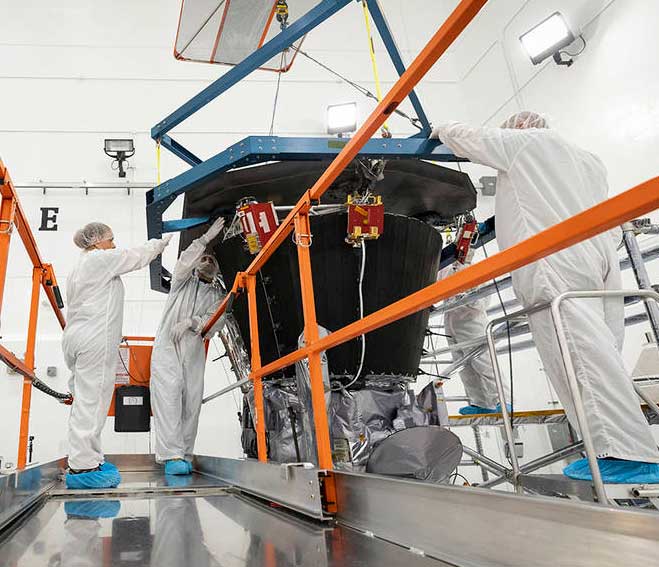There are things we simply do not understand about the sun. The surface is 5,778 K, and yet the chromosphere, transition region, and corona are much hotter.
Why?
There are some ideas, but nobody knows.
In order to answer such questions we need to go and take a closer look and that is what the Parker Solar Probe is all about. I was writing about it just over one year ago in June 2017 and so it is time for an update.
We have a launch window
The window for launch is now just weeks aways: 31st July – 19th Aug
It's #SunDay! ☀️ In just a few weeks, we're launching Parker #SolarProbe to get closer to the Sun than any spacecraft has ever gone. Follow along with the countdown to launch: https://t.co/gDQOdAlFkt pic.twitter.com/LxPIrhRY10
— NASA Sun & Space (@NASASun) July 15, 2018
Faster, closer, hotter than ever before
This will be quite literally a record breaking probe.
- Faster – It will become the fastest ever human object – At closest approach, Parker Solar Probe hurtles around the Sun at approximately 430,000 mph (700,000 kph). That’s fast enough to get from Philadelphia to Washington, D.C., in one second.
- Closer – On the final three orbits, Parker Solar Probe flies to within 3.8 million miles of the Sun’s surface – more than seven times closer than the current record-holder for a close solar pass, the Helios 2 spacecraft, which came within 27 million miles in 1976 and more than 10 times closer than Mercury, which is about 42 million miles from the Sun.
- Hotter – At closest approach to the Sun, the front of Parker Solar Probe’s solar shield faces temperatures approaching 2,500 F (1,377 C). The spacecraft’s payload will be near room temperature.
What exactly will it do?
Rather obviously the solar wind, corona, and dynamics of the magnetic fields will be measured and explored. They explain it as follows …
The primary science goals for the mission are to trace how energy and heat move through the solar corona and to explore what accelerates the solar wind as well as solar energetic particles. Scientists have sought these answers for more than 60 years, but the investigation requires sending a probe right through the 2,500 degrees Fahrenheit heat of the corona. Today, this is finally possible with cutting-edge thermal engineering advances that can protect the mission on its dangerous journey. Parker Solar Probe will carry four instrument suites designed to study magnetic fields, plasma and energetic particles, and image the solar wind.
Well yes, so let’s for a moment or two get a bit more technical. There are five major instruments within the package …
- Electromagnetic Fields Investigation (FIELDS) — This investigation will make direct measurements of electric and magnetic fields, radio waves, Poynting flux, absolute plasma density, and electron temperature. Its main instrument is a flux-gate magnetometer. The Principal investigator is Stuart Bale, at the University of California, Berkeley.
- Integrated Science Investigation of the Sun (IS☉IS)— This investigation will measure energetic electrons, protons and heavy ions. The instrument suite is composed of two independent instruments, EPI-Hi and EPI-Lo. The Principal investigator is David McComas, at the Princeton University.
- Wide-field Imager for Solar PRobe (WISPR)— These optical telescopes will acquire images of the solar corona and inner heliosphere. The Principal Investigator is Russell Howard, at the Naval Research Laboratory.
- Solar Wind Electrons Alphas and Protons (SWEAP)— This investigation will count the electrons, protons and helium ions, and measure their properties such as velocity, density, and temperature. Its main instruments are two electrostatic analyzers and a Faraday cup. The Principal Investigator is Justin Kasper at the University of Michigan and the Smithsonian Astrophysical Observatory.
- Heliospheric origins with Solar Probe Plus (HeliOSPP) is a theory and modeling investigation to maximize the scientific return from the mission. The Principal Investigator is Marco Velli.
You can find more details here. When I say detail, I really do mean it. That last link takes you to a 48 page paper that lays out the precise details of the questions being asked and hopefully answered. It has been written by the researchers involved.
Finally – Why is it called the Parker Solar probe?
It is a NASA tradition to name things after people who have made a deeply meaningful contribution to our understanding in a related field. For example the Hubble space telescope was of course named after the astronomer Edwin Hubble. In this instance the solar probe is named after Eugene Parker who in the mid-1950s proposed a number of concepts about how stars give off energy. Much of his pioneering work, which has been proven by subsequent spacecraft, defined a great deal of what we know about the how the sun–Earth system interacts.
You might wonder what such individuals would think about having such cutting edge technology named in their honour. Generally we can never know, but in this case we can. In a first, NASA named it to honour a living individual, because Eugene Parker aged 91 commented on it …
Speaking at the press conference Nicola Fox, mission project scientist at the Johns Hopkins University Applied Physics Laboratory, added that a chip would be placed on board the spacecraft carrying pictures of Parker and his scientific papers, as well as a plate with an inscription of his choice. Parker was then presented with a model of the probe.
… Dressed in a black suit and tie, Parker said that he was privileged that the mission had been named after him. “I am greatly honoured to be associated with such a heroic scientific space mission,” he said, explaining that designing a spacecraft to withstand temperatures so close to the sun is a considerable feat.
